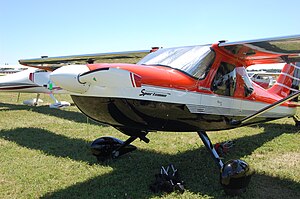Glasair Sportsman 2+2
| Glasair Sportsman 2+2 | |
|---|---|

| |
| Role | Civil kit aircraft |
| Manufacturer | Glasair |
| Status | In production |
| Produced | 2003 to date |
| Developed from | Glasair GlaStar |
The Glasair Sportsman 2+2 is a single-engine, high wing, strut-braced, four seat kit aircraft, developed by the Glasair Aviation company.[1][2]
Design and development[]
The Sportsman 2+2 was developed from the company's Glastar aircraft, a smaller version. The company's 'Two weeks to taxi' program provides factory-assisted assembly, while providing the owner with training in using tools and jigs. This complies with the Federal Aviation Administration's 51% construction rule, allowing issuance of a Special Certificate of Airworthiness as an amateur-built aircraft.[3][4]
The aircraft can be fitted with tricycle landing gear or conventional landing gear and can also be equipped with floats and amphibious floats or tundra tires.[2]
The aircraft is constructed with a fiberglass fuselage, or optionally from carbon fiber, with all metal wings and horizontal stabilizer and elevator. The airplane is available with a 180 hp (134 kW)Lycoming IO-360 engine or a 210 hp (157 kW) Lycoming IO-390 engine with an optional constant speed propeller.[5]}





Variants[]
- Glasair Sportsman 2+2 Diesel
- A Thielert Centurion 2.0s powered variant.
- Carbon Sportsman
- A variant with the fuselage constructed of carbon fiber rather than fiberglass. The weight savings of carbon fiber are negated by heavier duty cage, wing struts, and wing skins; both variants have the same empty weight, but the carbon variant gross weight is increased 150 lb.[5]
Specifications (Sportsman 2+2)[]
Data from Glasair website[5]
General characteristics
- Crew: one
- Capacity: three passengers
- Length: 23 ft 0 in (7.01 m)
- Wingspan: 35 ft 0 in (10.67 m)
- Height: 6 ft 11 in (2.11 m) on conventional landing gear
- Wing area: 131 sq ft (12.2 m2)
- Aspect ratio: 9.1:1
- Empty weight: 1,350 lb (612 kg) (typical)
- Gross weight: 2,350 lb (1,066 kg) on wheels
- Fuel capacity: 50 US gallons (189 litres)
- Powerplant: 1 × Lycoming IO-360 , 180 hp (130 kW)
- Propellers: 2-bladed Hartzell constant-speed propeller
Performance
- Maximum speed: 167 mph (269 km/h, 145 kn) TAS at Sea Level
- Cruise speed: 158 mph (254 km/h, 137 kn) at 75% power, TAS
- Stall speed: 48 mph (77 km/h, 42 kn) flaps down
- Range: 829 mi (1,334 km, 721 nmi) with VFR reserves, at 65% power
- Service ceiling: 20,000 ft (6,100 m) estimated
- g limits: +3.8/-1.5 g
- Rate of climb: 1,000 ft/min (5.1 m/s) at maximum gross weight
- Wing loading: 17.5 lb/sq ft (85 kg/m2)
References[]
- ^ Vandermeullen, Richard: 2012 Kit Aircraft Buyer's Guide, Kitplanes, Volume 28, Number 12, December 2011, pages 55-56. Belvoir Publications. ISSN 0891-1851
- ^ a b Tacke, Willi; Marino Boric; et al: World Directory of Light Aviation 2015-16, page 109. Flying Pages Europe SARL, 2015. ISSN 1368-485X
- ^ DIY Plane: From Toolbox to Takeoff in Two Weeks | Autopia | Wired.com
- ^ "AirCrafters Builder Assistance for Experimental Aircraft - The 51% Rule and the FAA". Archived from the original on 2011-07-07. Retrieved 2010-11-23.
- ^ a b c Glasair (2014). "Glasair Sportsman specs". www.glasairaviation.com. Archived from the original on 14 August 2014. Retrieved 4 August 2014.
External links[]
 Media related to Glasair Sportsman at Wikimedia Commons
Media related to Glasair Sportsman at Wikimedia Commons- Kitplanes Review: Sportsman in Transition
- Homebuilt aircraft
- Single-engined tractor aircraft
- Glasair aircraft